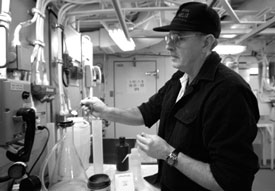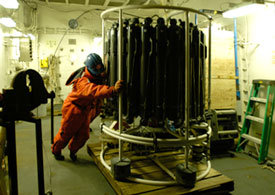 |
Daily Update
Calendar
Dispatch 28 - October 7, 2003
By C. A. Linder
Weather conditions: Overcast skies, 35 kt winds gusting to
50 kts, 8-12 ft seas, air temperature 28°F
Back to Work
After 42 hours of riding out the storm, we have resumed our CTD
and VPR section across the Beaufort
shelfbreak. The storm began to break at about noon, and by the time
darkness fell the waves had already settled from 12 foot monsters
to tame 3-4 foot swells. Snow flurries
pelted the ship intermittently during the day, and fog banks lurked
on the horizon. Winter definitely seems to have arrived on the Beaufort
Sea.
Although the down time was appreciated, some of the science party
members were definitely feeling cabin fever from the lack of activity.
There are only so many things to keep you occupied on the ship, especially
when it's too dangerous to stroll around the decks! The busier you
are at sea, the faster time flies and the sooner you are back home.
Dean Stockwell from the University of Alaska, Fairbanks is one of
the few people who managed to collect data through the storm. He takes
small samples of surface water that enter the ship through an intake
and saves them for chlorophyll analysis later. His research will tell
us how much plant matter (phytoplankton) is in the water.
Here are some questions from Mrs. Rollo's 5th grade class
at Varnum Brook Elementary School, Pepperell, Massachusetts.
Question from Thomas: What would happen if the
boat started to sink?
Answer: I asked the ship's Operations Officer,
Operations Officer, Lieutenant Commander Daryl Peloquin, to run through
a typical scenario in the event the ship suffers some damage to the hull and is taking
on water.
 |
 |
| Dean Stockwell prepares a water sample for chlorophyll analysis. |
| Click
to enlarge |
The Coast Guard sailors on the ship are all trained to respond to
emergencies, whether it is a fire or flooding or a person that has
fallen overboard. They practice, practice, practice every week so
that their reponse is automatic. In the event of flooding, first
an alarm would be sounded. The crewmen would attempt to seal the
leak or perhaps just close off that compartment so that the leak
can't spread. The ship is divided into compartments which are connected
by "water-tight doors."
These doors are designed to contain a leak if it occurs. If the
crew can't contain the leak and the ship is going down, the Captain
will make the decision to abandon ship. At this point a different
alarm is sounded and the crew members will begin another set of
tasks. Certain crew members would prepare the life rafts, others
would grab necessary items like navigation equipment, food, and
water. Then everyone would don an exposure suit called a "gumby
suit" and hop into the life rafts. The Healy is
equipped with emergency locater beacons that would automatically
broadcast a distress signal and position to the Coast Guard if the
ship is abandoned. Whoever receives the signal would then contact
the nearest vessel or shore station to begin the rescue attempt.
Even though nobody likes to think about abandoning ship, it's very
important to consider this and other safety issues every time you
get on a ship.
Question from Johnathan: Are there avalanches in
the Arctic?
Answer: Hi, Johnathan. Since sea ice is very flat,
there are no avalanches in the Arctic Ocean. Avalanches generally
occur on snowcovered mountainsides having a slope around 20-30 degrees.
If the slope is shallower than that, then avalanches aren't likely
to occur since gravity isn't exerting much of a pull on the snow.
If the slope is steeper, then it's hard for snow to build up on
the slope - it is more or less continually falling down the slope
as it accumulates. Thus, the danger of large avalanches is less.
Avalanche science is quite complicated; it involves a number of
factors in addition to the slope. One thing is for sure, though
- if you stay away from land in the Arctic, you're safe from avalanches!
 |
 |
| Martha Delaney and Seaman Trevor Hughes push the CTD out of the lab. |
| Click
to enlarge |
Question from Ben G: I know about blubber but if
the blubber is under the skin, why doesn't the skin get cold on
the animals?
Answer: I asked Lisa Munger to help me out with
this question since she is studying whales for her PhD thesis. She
answers:
"Marine mammal skin has two layers - the outermost layer is
the epidermis, which does not contain blood vessels or nerves. The
innermost layer is the dermis, and that is where the blubber is
found. The epidermis on right whales, which are similar to the bowhead
whales found in the Arctic, is over a centimeter thick! This forms
a protective coating over the blubber. So, since the epidermis is
in contact with the water, it does get cold, but the whale never
feels it! It's very similar to when you bundle up to go outside.
Your fleece or sweater traps your body heat and keeps it close to
your body. The outside of your waterproof shell jacket is in direct
contact with the rain, snow, and cold air, and it does get cold,
but you never feel it."
We expect to spend at least 30 hours completing this CTD section,
which should keep us hopping through tomorrow night. Since the weather
has been so fickle lately I won't make any predictions about where
we'll head after that!
 Previous
Dispatch
Next Dispatch Previous
Dispatch
Next Dispatch

Back to
Calendar
|




